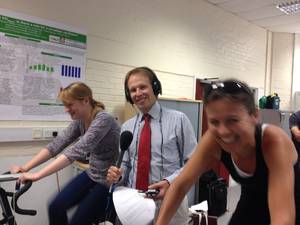Feeling the burn
Interview with
After five minutes cycling at Tour de France pace, both Kate and Karin are starting to feel the burn...
Dan - They're done just over 5 minutes now. What we can see is, if we look at Kate, Kate has done  remarkably well.
remarkably well.
Chris - You've actually done over 5 minutes at Tour de France pace.
Kate - Well, Dan, before we started, said that he thought I could only do 40 seconds! So I went out to prove him wrong! I think 5 minutes is a respectable improvement on 40 seconds!
Chris - You have gone rather red...
Kate - That would be the payoff.
Chris - Karin, how are you feeling?
Karin - I think it's tough now.
Chris - So, what can you tell us about the comparison between these two?
Dan - So, if we look at Kate's state at the moment; so Kate is averaging at the heart rate of 167. Actually, it went up to 174 not long ago. So, if you remember early on, it was about 155. So, the fact the heart rate has gone up, but the workload hasn't changed is indicating that Kate now is having to use more energy to maintain the same pace. The energy is coming from sources that do not use oxygen and these are the sources that cost you, they're anaerobic. So, if we look at Karin now, Karin's heart rate is 145. It has gone up, but it's only gone up marginally. And so, that's what you would expect from somebody who's aerobically very fit and is able to push through the pedal. A lot of this is about the mechanics of pushing and pulling and we understand that pushing is comfortable, but actually, it's more efficient to pull up on the pedal and use less energy for doing that. And somebody who cycles a lot has got mechanics to be able to do that.
Chris - Should we let them off now because I know you've got something else in store for them in a little while?
Dan - Okay, I think we should let them stop. Okay, well done guys.
Chris - You can stop. Defibrillator is in the corner if you need it. So Dan, what's the next trick we're going to subject them to in a minute?
Dan - Okay, so next what we're going to do is what we looked at was the average cadence that's used in the tour. But actually, what researchers started to show us is that cycling is much more efficient at higher cadences. In fact, if we look at the world class climbers, they actually cycle at much high cadences. They cycle at cadences around about 110 revs per minute. So, what we're going to ask Karin and Kate to do is repeat what they were doing in terms, we're going to keep them at the same relative workload, but we're going to ask them to do it this time rather than at 70 rpm, at 110 rpm.










Comments
Add a comment